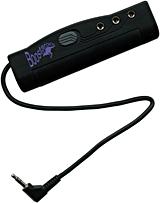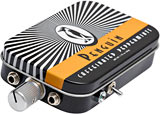
Boostaroo headphone amplifier
Review date: 3 August 1999.Last modified 03-Dec-2011.
Headphones are marvellous things. A good pair has sound reproduction qualities that would cost ten times as much from loudspeakers, and they may not get the floor moving, but they make up for it by letting you listen to whatever turns your crank at jetpipe reheat volume without inducing neighbours to call the National Guard.
But.
If more than one person wants to listen, headphones are a problem. You can put a splitter on a headphone jack and plug in two sets, but then you get half volume. Furthermore, even with only one pair of headphones, the power output from the headphone jack of many portable devices isn't sufficient to cut through the background noise with which they usually have to compete.
The oddly named Boostaroo is a low cost solution to both of these problems. Selling for $US17.95 (plus $US3.50 for U.S. shipping, plus $US5 for overseas orders), it's a three-output headphone amplifier that runs from two AA cells. It's got a power switch, but no volume control; it just boosts the volume of whatever you connect it to. The version I reviewed was the standard black one with a six inch input lead, designed for use with portable stereos and in any other application where a lot of cable is a bad thing. A grey version with a three foot cord sells for two U.S. bucks more.
The Boostaroo gives you 4dB gain over the input level on each of its output channels, which are completely separately amplified - you get the same volume from the headphones on one channel even if there are headphones connected to one, or both, of the other sockets.
What you get
The Boostaroo is 4.5" x 1.5" x 1.1" in size (11.43cm x 3.81cm x 2.79cm), barely longer than the two AA cells that power it, and not much wider either. It's a very compact, lightweight unit, and could easily be affixed via double-sided tape or Velcro or what have you to any portable stereo or similar gizmo. Out of one end pokes the input lead, terminating in a standard stereo 1/8th inch plug just like those on all smaller headphones, and on the side there are three matching 1/8th inch sockets, and a power switch. There's no power light, and there's no volume control. The manufacturers, Bowman Inc (their under-construction Web site is here; the much better actual Boostaroo site is here), say that the quiescent power drain of the Boostaroo when turned on isn't high enough to justify drawing more power to light an LED. And you set the volume of the Boostaroo output by setting the volume on whatever you've got it plugged into. Simple.
How's it sound?
A lot of cheap audio gear sounds pretty dire. This definitely goes for cheap headphones, which can mask the crumminess of a cheap personal stereo with their own special brand of crud. But since I've got an expensive pair of Sennheisers, I could actually hear what the Boostaroo did to the sound. In short - not much, except make it louder.
The Boostaroo adds a weeny bit of hum, but you've got to be listening for it - if you're using the Boostaroo to punch your headphone volume up past the rumble of the bus you're sitting on or the crash of the nearby waves, there's no way you'll notice it. The Boostaroo gets harsh at very high volume levels, but it drove the Sennheisers cleanly well into the headache zone. If you need more boost than the Boostaroo can provide to cut through the background noise wherever you are, I suggest you abandon your musical pursuits and instead invest in a good set of earplugs.
Power consumption
OK, so how much juice does the Boostaroo suck out of its two AAs?
Not very much, actually.
From 3 volts (V), the Boostaroo draws 8.2 milliamps (mA) when it's turned on but not doing anything. Plugging in one pair of headphones and winding up the volume to the distortion line (which is pretty high - certainly headache material) only raises the current draw to 15mA or so. Adding one or two more pairs of headphones further increases the draw proportionally; each set of 'phones accounts for another 8mA or so.
Given that AA alkaline cells are good for 2.4 amp-hours (Ah; 1000 milliamp-hours equals one amp-hour) or thereabouts, you could therefore have three people hooked up to a Boostaroo at high volume for some 80 hours straight before your power died. If you're listening solo, 160 hours is more like it.
Looking inside
The Boostaroo's plastic case is VERY firmly fixed together. It would take some time, and some care, to slice it open with a razor saw or Dremel cutting disc.
Fortunately, the battery bay has a raised edge on either side, and the faceplates on the jaws of my bench vise are narrow enough that, with the vise closed, the Boostaroo battery bay could be popped over them. Holding the Boostaroo down while winding the vise open created a sequence of alarming snapping sounds, followed by the sudden appearance of the Boostaroo circuit board.
Behold!
As it turns out, pretty much all of the Boostaroo's abilities are based on three Philips TDA7050 low voltage mono/stereo power amplifier ICs. These carry a unit price, by the way, of about 50 U.S. cents each, in quantities of 250 or more. You see now how they can sell these things for less than twenty bucks.
According to the Philips datasheet, from a 3V supply, each of the TDA7050s is good for 35mW output - but this is at 10% total harmonic distortion (THD). 10% is a clearly audible amount of distortion, but less than a lot of people put up with from crummy stereo equipment. It's generally agreed that about 1% THD is where distortion becomes audible, although with background noise the figure gets higher. When you bear in mind that an average pair of headphones will be flat out at between 10 and 20mW, the output power of the TDA7050 seems more than adequate, as indeed it is.
The makers claim 40mW per channel output power from 3V into 16 ohm headphones, which is, in my opinion, stretching the truth. I'm sure you can get that much, at the distorted redline, if you actually have 16 ohm headphones (most, these days, seem to be 32 ohm) but fortunately half that much should be plenty.
The little Philips amps will actually work with more supply voltage - they're good for twice as much power from 4.5 volts. The capacitors on the Boostaroo board are all 6.3V units, so it'd probably run fine from three cells, if you hacked in another AA cell. The management disclaims all responsibility, do at your own risk, et cetera.
Caveats
For a single listener, there's only any point in using a Boostaroo if the standard headphone output of whatever you're listening to doesn't go as loud as you'd like - or does, but only with unacceptable distortion. The Boostaroo will save a bit of battery power, but since it does so at the cost of carrying around another little battery-powered device, that's not actually a win.
The headphone outputs of many cheaper stereo components are not very good, because foregoing a proper headphone amp is a great way to cut costs, and also because every minute of battery life is valuable and a decent headphone amp will consume a decent amount of power. The Boostaroo site points this out, and I agree.
Another Boostaroo claim I agree with is the fact that crummy little built-in headphone amps commonly have very high distortion at higher volume levels, but are pretty clean at lower levels. The Boostaroo lets you keep the volume control at a lower setting, while maintaining a decent output volume.
I'm not as comfortable with the Boostaroo makers' claim that it "makes less expensive headphones sound much better as well as the improving the performance of more expensive headphones". If you're normally running the 'phones from a crummy headphone amp, then yes, but if you're running them from a headphone amp that's already as good as the Boostaroo - and those Philips chips in the Boostaroo aren't exactly exotic - then you'll get no benefit from it, unless you want to plug in two or three listeners.
The same goes for the Boostaroo site's claims about enhancing the sound from computer sound cards; if your sound card doesn't drive headphones very well (which could well be the case, for various cheaper cards) then a Boostaroo might give you a considerably better experience. Most sound cards these days seem to be perfectly capable of driving the 16 and, more commonly, 32 ohm loads of headphones, though; their on-board amplifiers are good for one or two fairly clean watts per channel into 8 ohms, and can output more than enough power into the higher impedance load of a set of headphones to slap the transducers against their stops and your eardrums against your brain.
The crumminess of a lot of sound card output is down to lousy source material - low sample rate game effects, or lots of effects mixed together in real time - or to an interference-prone signal path, which won't be cleaned up by plugging in an outboard headphone amplifier.
The makers also explicitly claim that the Boostaroo will increase the volume from your computer speakers, which is, in my opinion, bunk. Computer speakers are either plugged into a sound card Line Out connector and have their own amplifier, or are unamplified and plugged into the Speaker Out connector, which is fed by an on-board amplifier on the sound card. Either way, even crummy little computer speakers are driven by amplifiers rated at one or two watts per channel, versus a maximum of 35mW from the Boostaroo's amp chips running at the redline.
I tried the Boostaroo out on some 8 ohm speaker drivers and it could indeed drive them loudly enough for peaceful background-music listening in a small, quiet room. But this is certainly not what the little amplifiers are meant to do. A Boostaroo may well improve the sound from those funny little speakers that have a headphone plug on them and are meant to work from personal stereos. But since these things generally sound like a mouse farting in a distant eggcup, making them worthwhile is, to my mind, a lost cause.
By all means, try it yourself; take a set of cheapo non-amplified computer speakers, which will have a lead that terminates in a 1/8th inch stereo plug just like those used by headphones, and plug them into a few headphone jacks. You won't get much out of them from anything portable, and you won't get much more from the Boostaroo. And basic computer speakers generally have three or four inch drivers in them that are a great deal more efficient than the horrid little telephone-drivers used in micro-speakers.
While I'm whingeing, I'm also not entirely sure whether there's actually anything particularly Australian about the Boostaroo except its name. Bowman Inc are a U.S. company, and if the Boostaroo's inventor is actually Australian, the Boostaroo Web site doesn't explicitly say it. But no matter.
Overall
For the money, this is a great little bit of gear. It's not for everyone - if you've got a decent headphone amp in whatever it is you listen to, and one headphone socket is enough for you, then you don't need a Boostaroo. But if you want more grunt for your 'phones, or just want to be able to plug in two or three listeners to one source, the Boostaroo will do the job cleanly and cheaply. Recommended.




